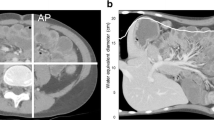Abstract
There has been increasing interest in adjusting CT radiation dose data for patient body size. A method for automated computation of the abdominal effective diameter of a patient from a CT image has previously only been tested in adult patients. In this work, we tested the method on a set of 128 pediatric patients aged 0.8 to 12.9 years (average 8.0 years, SD = 3.7 years) who had CT abdomen/pelvis exams performed on a Toshiba Aquilion 64 scanner. For this set of patients, age-predicted abdominal effective diameter extrapolated based on data from the International Commission on Radiation Units and Measurements was a relatively poor predictor of measured effective diameter. The mean absolute percentage error between the CTDI normalization coefficient calculated from a manually measured effective diameter and the coefficient determined by age-predicted effective diameter was 12.3 % with respect to a 32 cm phantom (range 0.0–52.8 %, SD 8.7 %) and 12.9 % with respect to a 16 cm phantom (range 0.0–56.4 %, SD 9.2 %). In contrast, there is a close correspondence between the automated and manually measured patient effective diameters, with a mean absolute error of 0.6 cm (error range 0.2–1.3 cm). This correspondence translates into a high degree of correspondence between normalization coefficients determined by automated and manual measurements; the mean absolute percentage error was 2.1 % with respect to a 32 cm phantom (range 0.0–8.1 %, SD = 1.4 %) and 2.3 % with respect to a 16 cm phantom (range 0.0–9.3 %, SD = 1.6 %).





Similar content being viewed by others
References
Brody AS, Frush DP, Huda W, Brent RL: Radiation risk to children from computed tomography. Pediatrics 120:677–682, 2007
Size-Specific Dose Estimates (SSDE) in Pediatric and Adult Body CT Examinations: Report of AAPM Task Group 204, American Association of Physicists in Medicine, College Park, MD, 2011
Strauss KJ, Goske MJ: Estimated pediatric radiation dose during CT. Pediatr Radiol 41(Suppl 2):472–482, 2011
International Commission on Radiation Units and Measurements: Appendix D: reports produced by the Health Protection Agency (HPA) (formerly National Radiological Protection Board, NRPB). J ICRU 5:87–92, 2005
Kleinman PL, Strauss KJ, Zurakowski D, Buckley KS, Taylor GA: Patient size measured on CT images as a function of age at a tertiary care children’s hospital. AJR Am J Roentgenol 194:1611–1619, 2010
Brady SL, Kaufman RA: Investigation of American Association of Physicists in Medicine Report 204 size-specific dose estimates for pediatric CT implementation. Radiology 265:832–840, 2012
Cheng PM: Automated Estimation of Abdominal Effective Diameter for Body Size Normalization of CT Dose. J Digit Imaging 26:406–411, 2013
Ikuta I, Sodickson A, Warden GI, Andriole KP, Khorasani R: Automated body size extraction using CT images to calculate water-equivalent diameter. Society of Imaging Informatics Annual Meeting, Orlando, FL, 2012
Wang J, Duan X, Christner JA, Leng S, Yu L, McCollough CH: Attenuation-based estimation of patient size for the purpose of size-specific dose estimation in CT. Part I. Development and validation of methods using the CT image. Med Phys 39:6764–6771, 2012
Wang J, Christner JA, Duan X, Leng S, Yu L, McCollough CH: Attenuation-based estimation of patient size for the purpose of size-specific dose estimation in CT. Part II. Implementation on abdomen and thorax phantoms using cross sectional CT images and scanned projection radiograph images. Med Phys 39:6772–6778, 2012
Author information
Authors and Affiliations
Corresponding author
Rights and permissions
About this article
Cite this article
Cheng, P.M., Vachon, L.A. & Duddalwar, V.A. Automated Pediatric Abdominal Effective Diameter Measurements Versus Age-Predicted Body Size for Normalization of CT Dose. J Digit Imaging 26, 1151–1155 (2013). https://doi.org/10.1007/s10278-013-9623-6
Published:
Issue Date:
DOI: https://doi.org/10.1007/s10278-013-9623-6




